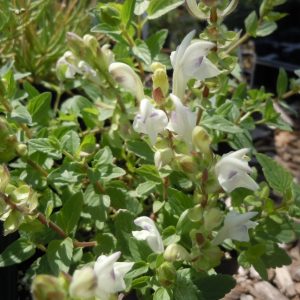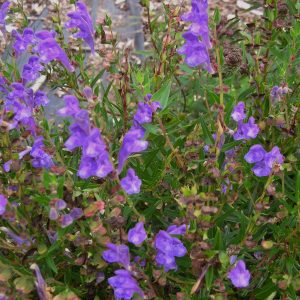Shop
Showing 657–664 of 788 results
-
Schizachyrium scoparium syn. Andropogon scoparium Little bluestem Z 3-9
Wispy, feather-like seedheads atop blue-grey foliage that turns plum-orange-red in fall.
Wispy, feather-like seedheads atop blue-grey foliage that turns plum-orange-red in fall
Size: 18" x 12"
Care: sun in well-drained soil.
Native: all No. America, Wisconsin native.
Wildlife Value: leaves are food for Skipper butterfly caterpillars and seeds food for songbirdsComanche used it to remedy syphilitic sores. Lakota made soft, wispy seedheads into liners for moccasins. Collected by French plant hunter André Michaux (1746-1802) in America’s prairies c. 1790
-
Schizophragma hydrangeoides ‘Rosea’ Pink Japanese hydrangea vine Z 5-8
Deciduous woody climber clinging by adhesive, aerial roots, with showy flower-heads resembling lacecap hydrangeas, with creamy-white flowers surrounded by showy bracts that age to rosy pink, blooming in July & August & its sepals remain conspicuous long after. Heart-shaped foliage turns yellow in fall.
ARCHIVED
Note: This is a plant not currently for sale. This is an archive page preserved for informational use.
Deciduous woody climber clinging by adhesive, aerial roots, with showy flower-heads resembling lacecap hydrangeas, with creamy-white flowers surrounded by showy bracts that age to rosy pink, blooming in July & August & its sepals remain conspicuous long after. Heart-shaped foliage turns yellow in fall.
Size: 20-30’ x 6-9’
Care: part shade to shade in moist to moist well-drained soil
Native: Japan where they “climb the trunks of tall trees and blossom among the lower limbs.” Arnold Arboretum Bulletin 1933.
Wildlife Value: Deer resistant.
Awards: Royal Horticultural Society Award of Garden Merit.‘Rosea’ found by English planthunter Charles Maries c. 1878, collecting for London’s Veitch Nursery and referred to in The Book of Climbing Plants and Wall Shrubs, Samuel Arnett 1902.
-
Scrophularia macrantha syn. Scrophularia coccinea Redbirds in a Tree, Mimbres figwort Z 5-10
This sub-shrub blooms from early summer until frost with white-lipped cherry-red, tubular flowers that look like a flock of inch-long, baby birds with open mouths waiting for food, each topping short stems along the branches. The margins of its oval green leaves are toothed.
OUT OF STOCK – EMAIL FOR AVAILABILITY
This sub-shrub blooms from early summer until frost with white-lipped cherry-red, tubular flowers that look like a flock of inch-long, baby birds with open mouths waiting for food, each topping short stems along the branches. The margins of its oval green leaves are toothed.
Size: 2-4’ x 18”
Care: sun to part shade in well-drained to moist well-drained soil. Little to no fertilizer.
Native: Three mountain tops in southern New Mexico (high elevations make it hardy to cold regions)
Wildlife Value: Its nectar is one of the best feeders and attractors for hummingbirds. Pollen and nectar also attract butterflies and bees.
Awards: 2008 Plant Select WinnerFirst collected on the Mexican Boundary Expedition by Charles Wright (1811-1885) and John Bigelow (1804-1878), “at the base of a rocky ledge near the summit of a mountain . . .a truly handsome species.” Described by Asa Gray, Torrey, John ed. Report on the United States and Mexican boundary survey Vol. 2 p. 111 (1859)
-
Scutellaria alpina Alpine skullcap Z 5-9
Mounds of two-toned snapdragon-like flowers July - October.
ARCHIVED
Note: This is a plant not currently for sale. This is an archive page preserved for informational use.
Bailey (1913): “A hardy spreading perennial about 10 in. high, with ovate, serrately dentate leaves and large, purple and white, somewhat yellowish flowers in dense, terminal racemes. … A handsome rock or low border perennial.” Mounds of two-toned snapdragon-like flowers July – October.
Size: 6-10” x 12”
Care: Sun in well-drained to moist well-drained soil
Native: Pyrenees, Appennines to the Balkans; central Russia to southern SiberiaLinnaeus’ imaginative mind named this genus after the Latin sculellum meaning “a little dish,” because of its resemblance to the flower’s helmet-shaped calyx. In gardens before 1753.
-
Scutellaria altissima Somerset skullcap Z 4-10
In early summer masses of upright stems bearing bi-colored, bluish-purple and white, snapdragon-like flowers, the hood being bluish-purple and the lower lip white. Flowers grow on one side of the spike. This will re-bloom if you cut the flowers.
In early summer masses of upright stems bearing bi-colored, bluish-purple and white, snapdragon-like flowers, the hood being bluish-purple and the lower lip white. Flowers grow on one side of the spike. This will re-bloom if you cut the flowers.
Size: 24-36” x 18-24”
Care: sun to part shade in moist well-drained to well-drained soil
Native: central & eastern Europe
Wildlife Value: pollen and nectar attracts bees and butterflies1st described and named in 1700 by Joseph Pitton Tournefort, French botanist.
-
Scutellaria baicalensis Chinese skullcap Z 4-8
Many stemmed clump, the top third of each stem bears one-sided ladders of rich purple flowers, from a tube connected to the stem opening into two petal-like hoods, one above the other, the top all purple and the bottom purple with a white blotch the shape of a handlebar mustache. This beauty blooms summer into fall.
OUT OF STOCK
Many stemmed clump, the top third of each stem bears one-sided ladders of rich purple flowers, from a tube connected to the stem opening into two petal-like hoods, one above the other, the top all purple and the bottom purple with a white blotch the shape of a handlebar mustache. This beauty blooms summer into fall.
Size: 12” x 12”
Care: sun in moist well-drained soil
Native: eastern Asia, Siberia
Wildlife Value: rabbit resistantLinnaeus’ imaginative mind named this genus after the Latin sculellum meaning “a little dish,” because of its resemblance to the flower’s helmet-shaped petal-like calyx. Used medicinally since ancient times in China to cure colds, fever, headaches, and insomnia.
-
Scutellaria diffusa Turkish skullcap Z 5-10
Small snapdragonish violet flowers with white markings on two adjacent lower lips looking like an open book in summer along short stems. Flower clusters top tidy mounds of sage-colored, oval, hairy leaves.
OUT OF STOCK
Small snapdragonish violet flowers with white markings on two adjacent lower lips looking like an open book in summer along short stems. Flower clusters top tidy mounds of sage-colored, oval, hairy leaves.
Size: 4-6” x 12”
Care: sun in well-drained soil
Native: Turkey, Lebanon and Syria
Wildlife Value: deer resistantFirst published by Swiss botanist A.P.de Candolle in Prodr. 12: 421 (1848)
-
Scutellaria incana syn. Scutellaria canescens, Scutellaria villosa Downy skullcap Z 4-9
Flowers of spikes of purple-blue tubes ending in two open lips, the lower lip having a white blotch, blooming for months from July to September, if deadheaded
Flowers of spikes of purple-blue tubes ending in two open lips, the lower lip having a white blotch, blooming for months from July to September, if deadheaded
Size: 2-3’ x 12-18"
Care: sun to part shade in moist well-drained to well-drained soil. Reblooms if deadhead after 1st flush of flowers
Native: NY to WI, Georgia to TX, Wisconsin native
Wildlife Value: Deer resistant. Its nectar feeds small butterflies, Bumblebees and Hummingbirds.The name Scuttelaria is from Latin scutella meaning a small dish or saucer referring to the shape of the persistent calyx, a covering at the flower’s base. Incana means grey referring to the tiny hairs on stems and undersides of leaves giving a greyish color. Named by Johann Friedrich Theodor Biehler, German botanist from the plant specimens in Christian Sprengel’s (1750-1816) herbarium in 1807. How did German botanist Sprengel, who never set foot in America, come to have a pressed specimen of this native American plant? Sprengel and German botanist, minister and college president, Carl Ludwig Willdenow (1765-1812) were close collaborators. Another German botanist Heinrich Ernst Muhlenberg (1753-1815), living in Lancaster Pennsylvania, sent many American plants specimens to Willedenow. Scutellaria incana is native to and grows in what is now called Muhlenberg Meadow in Lancaster County PA. These connections make it likely that the specimen Biehler saw came from Henry Muhlenberg.





